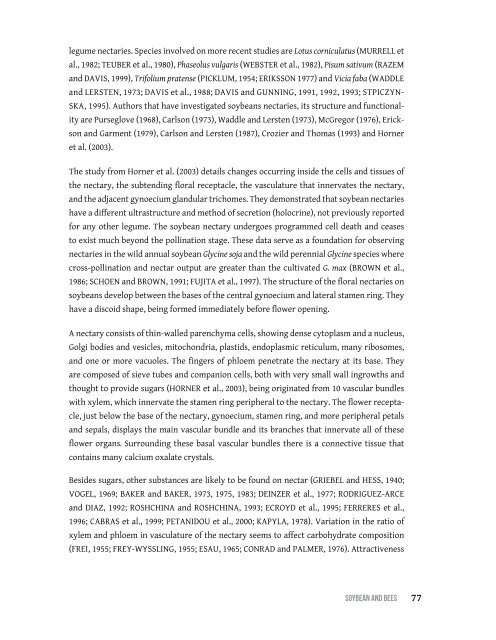Soybean and Bees
You also want an ePaper? Increase the reach of your titles
YUMPU automatically turns print PDFs into web optimized ePapers that Google loves.
legume nectaries. Species involved on more recent studies are Lotus corniculatus (Murrell et<br />
al., 1982; Teuber et al., 1980), Phaseolus vulgaris (Webster et al., 1982), Pisum sativum (Razem<br />
<strong>and</strong> Davis, 1999), Trifolium pratense (Picklum, 1954; Eriksson 1977) <strong>and</strong> Vicia faba (Waddle<br />
<strong>and</strong> Lersten, 1973; Davis et al., 1988; Davis <strong>and</strong> Gunning, 1991, 1992, 1993; Stpiczynska,<br />
1995). Authors that have investigated soybeans nectaries, its structure <strong>and</strong> functionality<br />
are Purseglove (1968), Carlson (1973), Waddle <strong>and</strong> Lersten (1973), McGregor (1976), Erickson<br />
<strong>and</strong> Garment (1979), Carlson <strong>and</strong> Lersten (1987), Crozier <strong>and</strong> Thomas (1993) <strong>and</strong> Horner<br />
et al. (2003).<br />
The study from Horner et al. (2003) details changes occurring inside the cells <strong>and</strong> tissues of<br />
the nectary, the subtending floral receptacle, the vasculature that innervates the nectary,<br />
<strong>and</strong> the adjacent gynoecium gl<strong>and</strong>ular trichomes. They demonstrated that soybean nectaries<br />
have a different ultrastructure <strong>and</strong> method of secretion (holocrine), not previously reported<br />
for any other legume. The soybean nectary undergoes programmed cell death <strong>and</strong> ceases<br />
to exist much beyond the pollination stage. These data serve as a foundation for observing<br />
nectaries in the wild annual soybean Glycine soja <strong>and</strong> the wild perennial Glycine species where<br />
cross-pollination <strong>and</strong> nectar output are greater than the cultivated G. max (Brown et al.,<br />
1986; Schoen <strong>and</strong> Brown, 1991; Fujita et al., 1997). The structure of the floral nectaries on<br />
soybeans develop between the bases of the central gynoecium <strong>and</strong> lateral stamen ring. They<br />
have a discoid shape, being formed immediately before flower opening.<br />
A nectary consists of thin-walled parenchyma cells, showing dense cytoplasm <strong>and</strong> a nucleus,<br />
Golgi bodies <strong>and</strong> vesicles, mitochondria, plastids, endoplasmic reticulum, many ribosomes,<br />
<strong>and</strong> one or more vacuoles. The fingers of phloem penetrate the nectary at its base. They<br />
are composed of sieve tubes <strong>and</strong> companion cells, both with very small wall ingrowths <strong>and</strong><br />
thought to provide sugars (Horner et al., 2003), being originated from 10 vascular bundles<br />
with xylem, which innervate the stamen ring peripheral to the nectary. The flower receptacle,<br />
just below the base of the nectary, gynoecium, stamen ring, <strong>and</strong> more peripheral petals<br />
<strong>and</strong> sepals, displays the main vascular bundle <strong>and</strong> its branches that innervate all of these<br />
flower organs. Surrounding these basal vascular bundles there is a connective tissue that<br />
contains many calcium oxalate crystals.<br />
Besides sugars, other substances are likely to be found on nectar (Griebel <strong>and</strong> Hess, 1940;<br />
Vogel, 1969; Baker <strong>and</strong> Baker, 1973, 1975, 1983; Deinzer et al., 1977; Rodriguez-Arce<br />
<strong>and</strong> Diaz, 1992; Roshchina <strong>and</strong> Roshchina, 1993; Ecroyd et al., 1995; Ferreres et al.,<br />
1996; Cabras et al., 1999; Petanidou et al., 2000; kapyla, 1978). Variation in the ratio of<br />
xylem <strong>and</strong> phloem in vasculature of the nectary seems to affect carbohydrate composition<br />
(Frei, 1955; Frey-Wyssling, 1955; Esau, 1965; CONRAD <strong>and</strong> PALMER, 1976). Attractiveness<br />
SoybeAn <strong>and</strong> bees<br />
77


